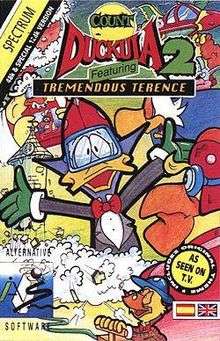Count Duckula 2
Count Duckula 2 is a computer game for the ZX Spectrum and Amstrad CPC released in 1992 by Alternative Software.
| Count Duckula 2 | |
|---|---|
 | |
| Publisher(s) | Alternative Software |
| Series | Count Duckula |
| Platform(s) | ZX Spectrum, Amstrad CPC |
| Release | 1992 |
| Genre(s) | Platform |
| Mode(s) | Single player |
It was the follow-up to the 1989 release Count Duckula in No Sax Please—We're Egyptian. Both are tie-in licenses of the Cosgrove Hall Count Duckula cartoon series.
Gameplay
Count Duckula 2 is a platform game in which the player advances Duckula from screen to screen shooting soft toys with a ketchup gun.
Reception
Critically, the game consistently achieved some of the lowest review scores of the 8-bit era and is considered one of the worst games published for these platforms. Sinclair User reviewed the game, awarding it 64%, concluding: "If you like silent, slow, basic, dated, unresponsive, annoying games, get it!"[1] The Your Sinclair review was more scathing, awarding 9%: "The whole thing seems to play quite happily by itself, with the player being a sort of novelty bonus."[2] The Amstrad CPC version fared no better, with Amstrad Action awarding the game a mere 3%. In the final issue of Your Sinclair, Count Duckula 2 was voted the "Worst Game Of All Time by the magazine's readers.[3]
The Amstrad CPC version of Count Duckula 2 is featured in Stuart Ashen's (also known by his online presence as Ashens) 2015 book Terrible Old Games You've Probably Never Heard Of, in which he states that "The Amstrad is capable of displaying a low resolution mode with 16 colors, similar to the Commodore 64 but with a larger potential palette and more vivid hues. But it can also produce a higher resolution screen similar to the Spectrum, albeit with only four colors at once. It also shares the same processor which led to developers realising they could port over the code of a Spectrum game in a few days. It would have fewer colors than the original version and run much slower ... Count Duckula 2 is one of the very worst examples of a lazy conversion. And as the game is distressingly poor in the first place, Alternative Software took something dreadful and made it into something frankly unholy."[4] Ashens criticises Count Duckula 2's graphics, calling them "absolutely dreadful" and expresses that many of the sprites are difficult to parse due to being reduced to two colors without being redrawn.[4]
Ashens criticises the lack of a jumping animation for Duckula, and says that enemies and platforms feature "minimal" animation, stating in regards to moving platforms that they "[flicker] in and out of existence at different points on the screen" instead of moving, and notes a glitch where the player can get stuck on moving platforms if they jump onto the edge of the platform.[4] Ashens calls the controls "painfully unresponsive" with "a lag of around half a second" between the player hitting a button and the game responding.[4] Ashens harshly criticises a fatal glitch in the Amstrad CPC release; the game prevents the player from platforming to an upper level, instead treating it as a ceiling that the player cannot go through.[4] This causes the second room in the game to be "impossible to complete by standard means", and Ashens notes that the only way for the player to continue is to call Tremendous Terrence, who skips the player to the next level.[4] This level skip has limited uses, and Ashens calls Count Duckula 2 "an absolute travesty."[4]
References
- Sinclair User issue 128 at World Of Spectrum
- Your Sinclair issue 84 at World of Spectrum
- Nash, Dennis, ed. (September 1993). "Let the People Decide! The Results". Your Sinclair. Vol. 1 no. 93. Future Publishing. pp. 11–12 – via Internet Archive.
- Ashen, Stuart (2015). Terrible Old Games You've Probably Never Heard Of (1st ed.). London, England: Unbound. pp. 46–53. ISBN 978-1-78352-256-9.
External links
- Count Duckula 2 at SpectrumComputing.co.uk